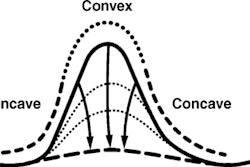A pilot study presented at 2008 American Association for Cancer Research (AACR) meeting is the first to demonstrate the value of diffusion-weighted MRI (DW-MRI) for nodal staging in head and neck squamous cell carcinoma (HNSCC), according to investigators from Belgium.
In a study of 20 patients with locally advanced HNSCC, the ability of DW-MRI to distinguish between malignant and benign lymph nodes was compared to the accuracy of conventional imaging (CT and turbo spin-echo MRI), as well as pathology results, according to researcher Piet Dirix of the department of radiation oncology at St. Augustinus Hospital in Wilrijk, Belgium. The superior results achieved with DW-MRI could significantly affect radiation therapy planning (RTP), especially when using newer conformal beam-shaping techniques, Dirix said.
"When we irradiate patients with new conformal techniques, it's important to know where the tumor is located," Dirix said. "Instead of irradiating the whole neck in HNSCC, we want to zero in on the places where the tumor is located, and spare normal tissue. Lymph node staging is important because it has an impact on where radiotherapy will be delivered, and ultimately on how much toxicity the patients might experience."
In the study, DW-MRI had a sensitivity of 88.9% and specificity of 97.4%, compared with a sensitivity of only 42.2% and a specificity of 93.5% in patients who received both CT and conventional MRI as part of their radiation therapy planning. DW-MRI correctly detected nodal cancer in four patients who were graded as having no nodal disease with conventional imaging. It also found bilateral disease in two patients who were thought to have unilateral disease when conventional imaging was used.
The investigators also calculated the differences in tumor-volume findings between DW-MRI and pathology and conventional imaging and pathology, and found that DW-MRI was significantly more accurate.
The investigators used a 1.5-tesla MRI scanner (Siemens Healthcare, Malvern, PA) for their diffusion-weighted imaging, Dirix said. He noted that although they did not compare DW-MRI to FDG-PET, the accuracy of both imaging techniques is comparable. "The numbers achieved with FDG-PET in other studies are similar to those we have seen in this research. They're both very promising techniques," Dirix added.
He noted that DW-MRI may have superior spatial resolution compared to FDG-PET, however, which may be advantageous in planning radiotherapy for HNSCC patients. "We were able to detect lymph nodes as small as 0.3 cm with DW-MRI, so DW-MRI is probably more accurate for staging very small lymph nodes," he said.
As a result of their study, the Belgium researchers have incorporated DW-MRI into their treatment plans for HNSCC patients, Dirix said.
By Barbara Boughton
AuntMinnie.com contributing writer
June 3, 2008
Related Reading
Diffusion-mapping MRI predicts radiation therapy response, April 22, 2008
PET plays universal role in pre- and post-treatment for head and neck cancer, April 26, 2007
Copyright © 2008 AuntMinnie.com


















